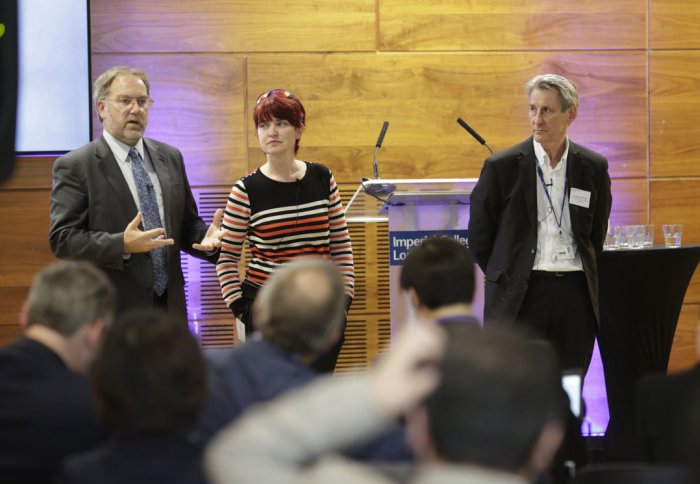
Professors Robin Grimes, Mary Ryan and Neil Alford take questions from the London Diplomatic Science Club.

Imperial hosted diplomats and scientific representatives from scores of partner countries on Tuesday evening.
The London Diplomatic Science Club (LDSC), which brings together science attachés from London’s embassies and high commissions, as well as the UK government, Royal Society, research councils and academic representatives, held its latest meeting at Imperial.

President Alice Gast
The Club last came to Imperial in 1997, when the College’s then-Rector Lord Oxburgh used the occasion to urge scientists to take a more multidisciplinary approach to research – something that is now engrained into Imperial’s work at all levels.
Lord Oxburgh’s most recent successor, the current President of Imperial Professor Alice Gast, said that multidisciplinary work “remains fundamental to Imperial’s approach to this day, where we continue to be guided by our mission of achieving enduring excellence in research and education in science, engineering, medicine and business for the benefit of society.”
PechaKucha
Imperial has arguably Europe’s best materials science department.
– Professor Alice Gast
President
During last night’s event, a group of Imperial experts delivered fast-paced ‘PechaKucha’ presentations on the future of materials. The researchers, Professors Mary Ryan, Neil Alford, Robin Grimes and Natalie Stingelin, previously delivered those presentations at the World Economic Forum in Davos this January. A lively Q&A session, chaired by Professor Maggie Dallman, followed.
Professor Alford showed how his group’s breakthroughs using masers are helping solve the growing problem of electronic noise in an increasingly data-rich and data-polluted world.
Professor Ryan spoke about her work at the cutting-edge of new materials that blend chemistry and nanostructure to manage and use waste heat to create electricity.
Professor Stingelin, who appeared via video, discussed the production of new materials at scale to manipulate light with extreme precision, promising energy-efficient glazing, best-in-class solar cells and new components for optical computing.
Professor Grimes explained how computer simulations are helping to predict and create tomorrow’s materials.
Professor Grimes, a materials physicist who also serves as the Foreign and Commonwealth Office’s Chief Scientific Advisor, was instrumental in re-launching the LDSC following a dormant period, alongside Hungarian Science and Technology Attaché and current LDSC chair Aniko Dobi-Rozsa, who also spoke at the Imperial event.

Global community
Introducing the event, Imperial’s President Alice Gast said: “A core feature of Imperial is that it’s at the heart of a global community. Over 50% of our staff are from countries outside of the UK, and the same is true of our students. This means that we truly understand the importance and benefits of international partnership. In the past year, over three quarters of our research papers resulted from collaborations with co-authors from over 140 countries and 6,000 different universities, businesses and research organisations around the globe.
“As a result, we have become a trusted interface for government and industry, both informing policy makers and, crucially, translating our research into viable solutions. We think this is a central role of what modern universities should stand for.”

An Imperial string quartet entertained guests
She referred to this year’s key theme at Davos, the ‘Fourth Industrial Revolution’, which “builds upon the three preceding revolutions and brings us to a new world of physical, digital and biological integration. What is exciting about this revolution is the way it takes us from the internet to the internet of things, from mass communication to disruptive ways of producing and designing medicines, materials, and devices.”
“At the heart of this revolution are ‘things’, goods, medicines, devices, objects. This leads us to need to understand physics, chemistry, electronics, mechanics and biology. In short, we need the amalgam of all of these disciplines in materials science… Materials scientists analyse the properties of materials at the molecular level. They create new materials with new properties and they model how materials will react and respond to signals, stimulus or light and heat. Imperial College London has arguably Europe’s best materials science department, and we have four of our stars to speak to you today.”
Article text (excluding photos or graphics) available under an Attribution-NonCommercial-ShareAlike Creative Commons license.
Photos and graphics subject to third party copyright used with permission or © Imperial College London.
Reporter

Andrew Scheuber
Communications Division

Contact details
Email: press.office@imperial.ac.uk
Show all stories by this author





Leave a comment
Your comment may be published, displaying your name as you provide it, unless you request otherwise. Your contact details will never be published.